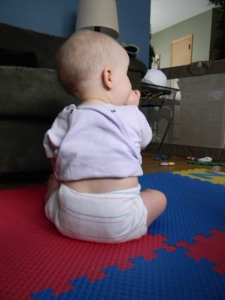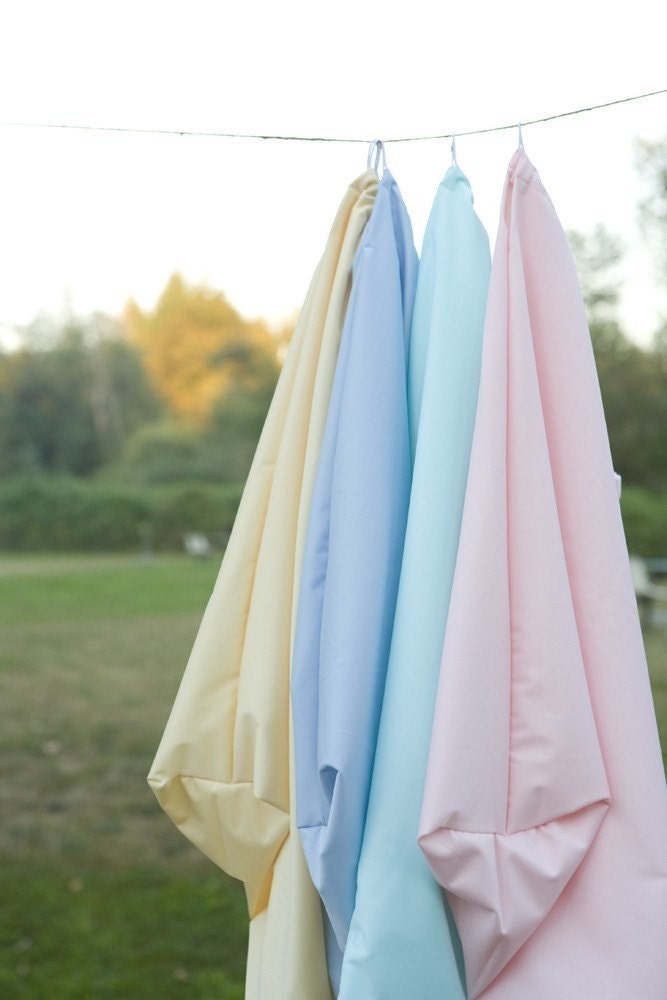Choosing a Cloth diaper
When choosing a diaper system you need to define a few things before you begin.
- What’s your budget
- Do you want high quality diapers, medium quality (this will affect your budget)
- Do you want only natural fibers in your diapering system, Mix or it doesn’t really matter
- Can you sew, do you think you could make diapers
- Do you want a really easy system so that anyone could use, do you want a mix of different systems (I recommend a mix)
Choosing
a diaper system is something you should go through with your husband
(after all he is going to be doing diaper changes too). In fact it’s
something that the whole family can get involved with (you can choose
one system for home, one for on the go, one for daddy/ grandparent
ease). I have seen couples in stores with the grandparents going over
the different diapers and choosing a system that works for the
grandparents.
Here are some of the different systems to choose from:
[youtube http://www.youtube.com/watch?v=R72mqYQ9XCA]
All In One diapers or AIO
are diapers that are the simplest diapers for anyone to use. You don't
have to stuff them and they are water proof. These diapers have to be
washed after every use.
All In 2 Diapers (AI2) are a
lot like AIO diapers The only difference is that the insert snaps in.
The difference between the two is that The all in 2 dries faster since
the insert can be unsnapped and put in the dryer while the shell hang
dries. The AI2 can also have the insert removed and replaced with out
having to wash the shell (as long as the shell is not soiled) You can do
this a few times before you have to throw the shell in the wash.
Pocket Diapers are
like all in one and all in in 2 mixed together. the insert is on the
inside of the diaper like the AIO but it comes out via a pocket so like
the All In 2 the insert can go in the drier while the shell hang dries.
Like the AIO the pocket diaper has to be washed after every use.
Prefold Diapers are
one of my favorite diapers they are your mothers cloth diaper but they
are a classic. There are a few different folds. They are very versatile
and I would say a must for every stash. Instead of using diaper pins
they have snappies now which make changing time super easy especially if
you have a wiggly baby! These diapers are not water proof and do
require a cover. Next are
Fitted Diapers these are
just like AIO in the sense of ease to put on baby but they are not water
proof and do require a cover. They are great for night-time because the
whole diaper is absorbent not just the insert.These diapers must be
washed after every use. Last but not least are
Flat Diapers. Flat
diapers are a single large layer of cloth that must be folded into the
correct size to fit a baby. Flats must be pinned or you must use a
snappi to stay on the baby, They require a cover to be waterproof. Flat
diapers must be washed after each diaper change.
One Sized Diapers Can be an AIO, a pocket or a AI2 What makes it a one side is an adjustable rise to make the diaper very in size to fit baby as they grow.
All in One Diaper (AIO)
All In 2 (AI2)
Pocket Diaper
Fitted Diaper
Prefold Diaper
Flat Diaper
One Sized Diapers
Snappi
Covers
Wool Covers (Longies and shorties) Wool
fibers exteriors are hydrophobic (repel water) and the interior of
the wool fiber is hygroscopic (attracts water); this makes a wool
garment able to cover a wet diaper while inhibiting wicking, so outer
garments remain dry. Wool felted and treated with lanolin is water
resistant, air permeable, and slightly antibacterial, so it resists the
buildup of odor. Some modern cloth diapers use felted wool fabric for
covers, and there are several modern commercial knitting patterns for
wool diaper covers. Longies and shorties don't have to have pants put
over them. The longies and shorties are breathable and keep baby warm.
These covers don't have to be washed offten unless they get soiled or
start to stink. You must Lanolin them after every wash and they must be
washed by hand and are delicate when wet.
PUL Cover. PUL stands for polyurethane laminated, While looking up info on PUL I think
Celtic cloth describe
it best so I will just quote them. "PUL is a lot more technical than
just a plastic backing on fabric. The original application is the
medical field, and it is still used for this purpose. Like cloth
diapers, it is used to replace disposable products with reusable. It
provides the waterproof barrier needed in the medical field that can
survive multiple institutional washings. The laminate can also be
autoclaved, which is a very high heat steam sterilization process, to
make it safe for reuse even after it comes into contact with blood or
other bodily fluids. The polyurethane laminate can be customized by the
manufacturer and comes in different thicknesses. For cloth diapers, 1
mil or 2 mil is generally preferred. This allows for a good
stretch, complete waterproofing, and is still comfortable enough to wear
next to the skin. There are other options for waterproof fabric, but
PUL is so durable and reliably waterproof it has become a favorite for
cloth diapers. It has been truly kid tested! " This cover can be worn a
few times before washing unless soiled. Fleece Covers are breathable
like wool but are much less delecate, The have to be washed after every
use but can be washed with diapers and put in the dryer.
Fleece
Wool
PUL
Different
diaper systems are all good for different goals. If your baby has a
rash and you want to air her out without fear of her peeing on the floor
or pooping on the towel you might choose a fitted , flat or a prefold.
With or without a cover (wool and fleece only for that example) If you
are traveling a long distance you might choose an AIO with suede cloth
inner to keep baby dry or a pocket with a zorb insert. It all depends on the day to day situation.
Inserts
Pocket diapers are diapers that you stuff with an insert. Some AIO's have a pocket so you can add an insert for more absorbency. There are a few different types of Inserts.
Hemp is an all natural fiber that is very absorbent,
Hemp fibers are longer, stronger, more absorbent, and more mildew-resistant than cotton. Making it possible for a trim fitting diaper with out sacrificing absorbency.
Microfiber is a synthetic material, you usually get this type of insert with your pockets and used for many AIOS in the internal soaker. They “quickly” absorb making them great for fast wetters and
catching heavy wetters, overall on the absorbency scale not the most
dense. Microfiber should not be placed directly against your baby’s skin. It is so absorbent that is can suck the moisture from babies skin, but
underneath a flannel or fleece liner it is fine.
Zorb contains only tangled cellulose fibers from bamboo/cotton/viscose
and poly micro fiber, the same fibers found in virtually every AIO
diaper on the market – nothing else. These non-allergenic fibers are
non-allergenic, durable and easy to sanitize We manufacture Zorb in the USA and Canadian in modern facilities that are safe & friendly for workers and the environment.Zorb is extremely fast at moving
moisture around. Assaults are quickly spread over a wide area to
minimize saturation and leak off in the area that is peed on. To see
this drop a swatch into water, you will see the moisture moves instantly
through the fabric. Zorb is considerably more
resilient than fleeces and terrys, and way, way more resilient than
microfiber toweling. When you squish it using the typical pressure of a
baby (around 5psi), moisture simply moves to another part of the Zorb
web. Natural fiber knits are slow to move moisture around, so pressure
creates a leak off channel, polyester fleeces (micro and polar) and
microfiber terry towels have weak webs that collapse under any pressure,
they have the most trouble with leak off.
Thanks so much for reading my post and I hope that this information has helped you on your
Big Cloth Adventure.
Leticia From Letjoy Cloth Diapers









.jpg)






























 There's always a choice to make, and in the world of cloth diapers the choices are seemingly endless. Being a cloth diaper maker, my cloth diaper drawer is full of tester diapers made from every imaginable material and design. To show my appreciation to the kids for their willingness to change diapers, I always leave them the "easy" diapers to use. However, more and more these days I catch myself wanting to reach for those easy diapers. So what makes them easy? The hook and loop tape, of course! I know, it's the not-quite age-old question of velcro versus snaps (or neither). In my opinion, snaps and velcro win out over pins and Snappis, purely from an ease of use and convenience standpoint (there are other considerations). But we are talking about easy.
There's always a choice to make, and in the world of cloth diapers the choices are seemingly endless. Being a cloth diaper maker, my cloth diaper drawer is full of tester diapers made from every imaginable material and design. To show my appreciation to the kids for their willingness to change diapers, I always leave them the "easy" diapers to use. However, more and more these days I catch myself wanting to reach for those easy diapers. So what makes them easy? The hook and loop tape, of course! I know, it's the not-quite age-old question of velcro versus snaps (or neither). In my opinion, snaps and velcro win out over pins and Snappis, purely from an ease of use and convenience standpoint (there are other considerations). But we are talking about easy.




 Many new moms who, for whatever reason, will work outside the home after their precious baby arrives may feel overwhelmed by the thought of motherhood altogether, much less the idea of using cloth diapers. For some, I'm guessing, cloth diapering is a fleeting thought followed by the comforting idea of the convenience of disposables. This was not the case for me! Especially not with baby #2.
Many new moms who, for whatever reason, will work outside the home after their precious baby arrives may feel overwhelmed by the thought of motherhood altogether, much less the idea of using cloth diapers. For some, I'm guessing, cloth diapering is a fleeting thought followed by the comforting idea of the convenience of disposables. This was not the case for me! Especially not with baby #2.

